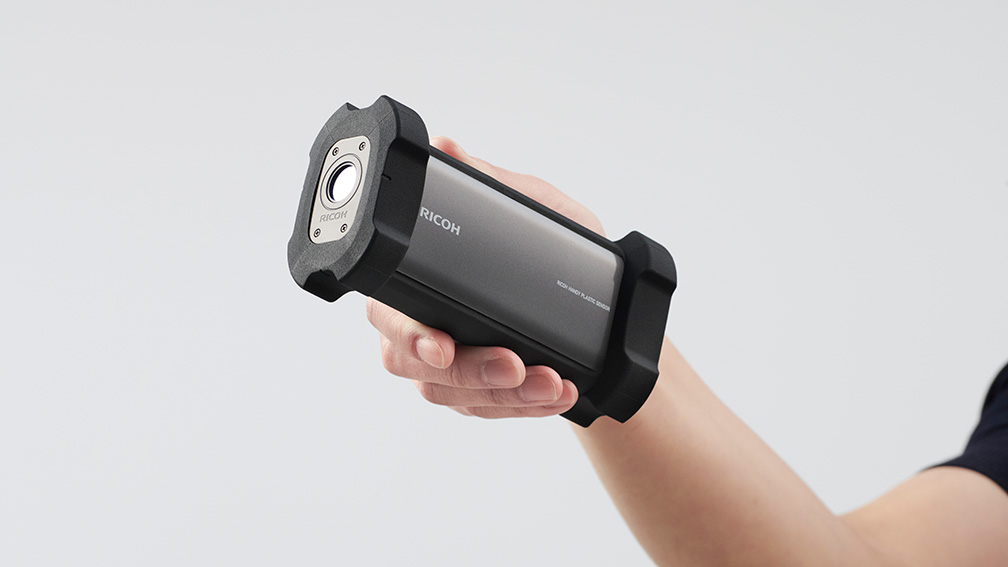Reduce the use of new resources and recycling initiatives
Design for Environment, 3Rs and Long-Term Usage
Main areas of activity of this initiative are highlighted on the Comet Circle.
Key partners.
‐Product manufacturer
‐Parts manufacturer
‐Materials manufacturer
‐Materials supplier
‐Maintenance company
‐Product recovery center
‐Parts recovery center
‐Materials recovery company
‐Collection center
‐Recycling center
‐Shredder company
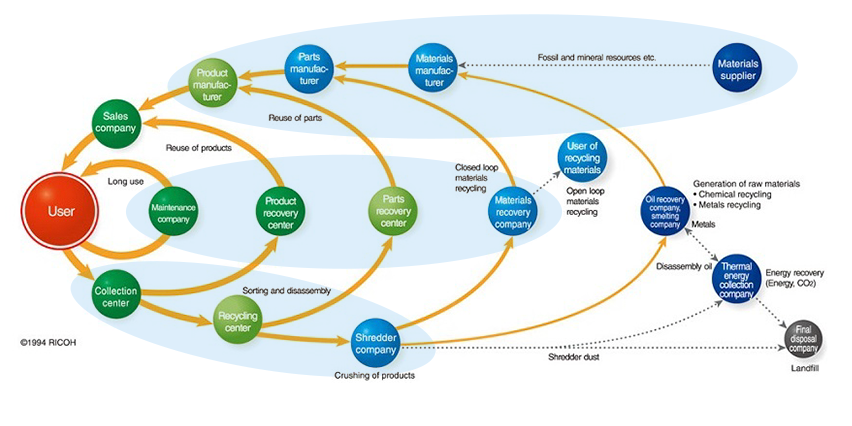
1. Design for Environment
Based on the Comet Circle™ concept, we have formulated and promoted the“ Recycling Design Policy” (current Design Policy for End of Life) for product design that considers reduce, reuse, recycle, and long-term use. For example, we have established various kinds of technological developments and know-how, such as strength design that assumes reuse, the improvement of dismantling and sortability, strength design to reduce packaging materials, and the extension of service life of replacement parts and key parts.
We review our Environmentally Friendly Design Policy from time to time, and make repeated revisions in line with social trends, markets, and internal activities. Designers conduct a self-assessment of environmentally friendly design at each design stage, and consideration of reduce, reuse, and recycle is established as one of the design procedures.
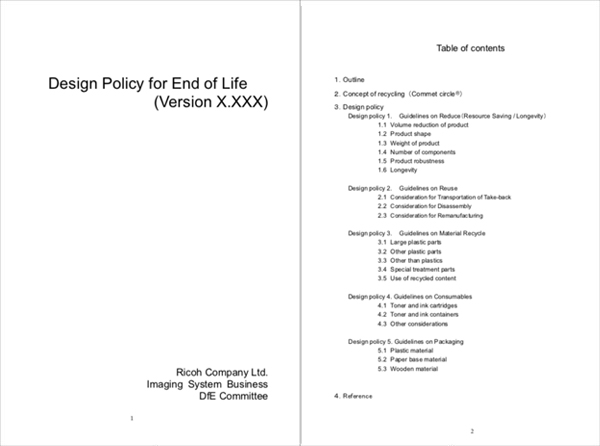
2. Use of compatible labels
We have developed compatible labels that maintain the purity and quality of recycled plastics even after the used parts are dissolved and reused with the labels left on them. The labels have been used for multifunctional printers (MFPs), and facsimiles since 1994. Eliminating the need to remove the labels has cut from the copier recycling process, thereby improving manufacturing efficiency.
3. Labeling the position of hidden screws and claws
Labeling the position of hidden screws and claws
Hidden screws and claws on the exterior cover impede reuse and recycling due to deterioration of disassembly and damage to parts. In 2015, we included in the design policy to indicate the positions of hidden screws and hidden claws on the exterior cover with the aim of reducing fastening parts and improving dismantling work efficiency while maintaining appearance quality.
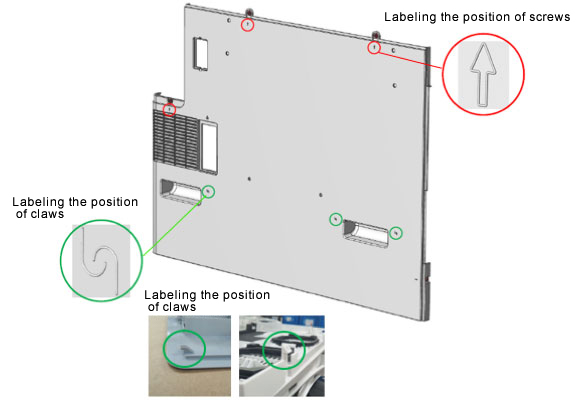
Reduce Product Sizes and Weights
Main areas of activity of this initiative are highlighted on the Comet Circle.
Key partners.
‐Product manufacturer
‐Parts manufacturer
‐Materials manufacturer
‐Materials supplier
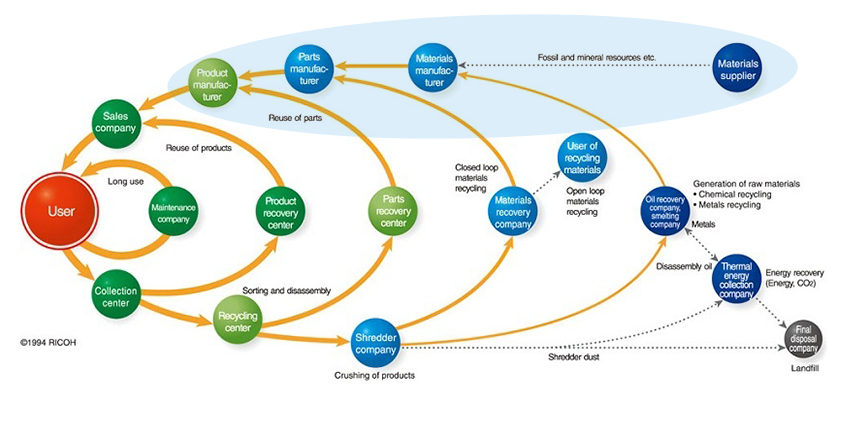
1.Reduce Product Sizes and Weights (MFPs and Printers)
To reach resource conservation targets, we reduced the sizes and weights of MFPs by setting specific weight targets not just for new models but for successor models to current products.
For RICOH MP C6003, C5503, C4503, C3503, and C3003 series color MFPs that we launched in June 2013, we conducted extensive strength and impact simulations and developed lightweight frames to reduce plastic and sheet metal thicknesses while reinforcing faces and corners to lower deformation. The new models thus weighed just 102 kilograms, which was more than 65% lighter than previous model. We reviewed paper transport paths and other areas to downsize duplexers and house them within the main units, thus shrinking footprints by 37%. These technologies are also utilized in the latest products*, and we are making effective use of resources and reducing the environmental impact by further reducing the size and weight.
* RICOH IM C6010/C5510/C4510/C3510/C3010/C2510/C2010 (Launched in Feb. 2023)
2. Staple reduction with “Internal Staple-less Finisher“
Ricoh has stolen the march on the rest of the industry by developing an “internal staple-less finisher” that utilizes a crimp-style double staple without conventional metal staples. This finisher was launched in December 2013.
This staple-free stapling binds documents (up to five standard papers) together with pressure instead of metal staples, reducing the time and effort needed to sort documents for disposal. The resources required to manufacture metal staples are thus conserved, making this an eco-friendly approach, and staple-free stapling is seen as enhancing safety at production sites for food products or precision instruments concerned about foreign objects in products, as well as at childcare facilities eager to prevent accidents such as children accidentally swallowing small objects.
The internal staple-less finisher is not only eco-friendly but also safe and easy to use, and providing this function on a greater range of machines will help conserve even more resources.
Reduction of packaging materials
Main areas of activity of this initiative are highlighted on the Comet Circle.
Key partners.
‐Product manufacturer
‐Parts manufacturer
‐Materials manufacturer
‐Materials supplier
‐Material recovery company
‐User of recycling materials
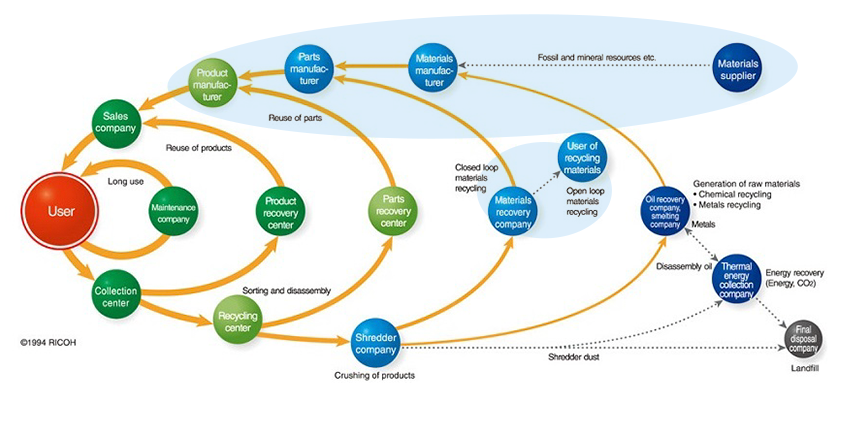
1.Reduce Product Sizes and Weights (MFPs and Printers)
We introduced eco-packaging in 1994 to conserve cardboard and reduce packaging materials. In 2001, we developed the returnable eco packaging made of resin introducing the market for the first time. In 2018, we brought out new returnable eco packaging for MFPs to further enhance the durability and recycling efficiency.
By improving the stackability when collecting packaging, the volume of the entire package has been reduced to a minimum to achieve low cost and high efficiency takeback. By using highly durable cardboard for the body of the packaging, it has become possible to ensure durability and reduce weight during repeated use.
While maintaining the strength of conventional eco-packaging, we have achieved a weight reduction of around 45% compared to previous one, reducing the work load and improving work efficiency.
We use the new returnable eco packaging for MFPs with remanufactured products shipped in Japan. Radio frequency identification tags on components has enabled us to streamline logistics through computer management of everything from shipments from plants through collections.
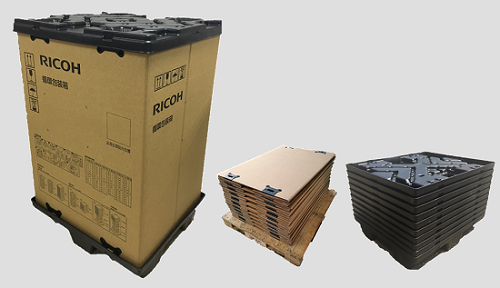
2. Factory kitting service using resource-recirculating eco packaging
Ricoh provides customers with a factory kitting service. Specifically, for product to be delivered to a customer, the company attaches optional items and configures the necessary settings, including IP addresses, according to the specifications of the customer. Ricoh then directly delivers the product and all other items packed as one unit to the customer. This service helps shorten the installation time of the machine, and also contributes to a substantial reduction of packaging materials compared with the traditional delivery of items separately packaged in cardboard.
Moreover, the factory kitting service contributes to substantially improving the efficiency of logistics operations through direct delivery from the factory to the customer, and also increasing the transportation efficiency by reducing the overall shipping volume.
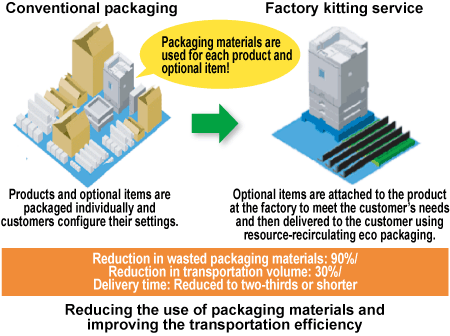
3. Reduction of plastic packaging
Packaging material for product transportation has generally used polystyrene foam (EPS) until now, which is derived from fossil resources, but the Ricoh Group is working to switch this to recyclable paper packaging. In order to overcome the problem of shock absorption, we use shock simulation technology to achieve the same high shock absorption performance as EPS, even with paper packaging materials that are harder than EPS.
The packaging of RICOH IM 9000, 8000, and 7000 A3 monochrome MFPs that we launched in January 2021 incorporated 36% less plastics by weight than previous model as a result of switching from EPS to corrugated cardboard materials.
The A3 Color MFPs“ RICOH IM C6010/C5510/C4510/C3510/C3010/C2510/C2010” released in February 2023 switched to a pulp mold that uses waste paper as raw materials and uses approximately 54% less plastic packaging material than its predecessor.
Furthermore, for the "Paper Feed Unit PB1200'' option for the A4 monochrome MFPs "RICOH IM 460F/370F'' released in July 2023, the product was packaged using white cardboard, which has better surface properties than regular cardboard and by eliminating plastic bags, we achieved "zero plastic usage*".
* Box sealing tape and product fixing tape are excluded
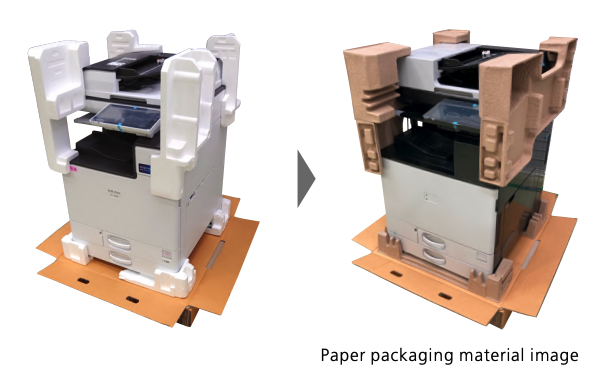
4. Using recycled materials for packaging tape
Since July 2021, we have used Nitto Denko CS System Corporation-developed adhesive packaging tape made from recycled plastic beverage bottles to pack some consumables and maintenance parts. We will keep striving to gradually use less single-use plastic.
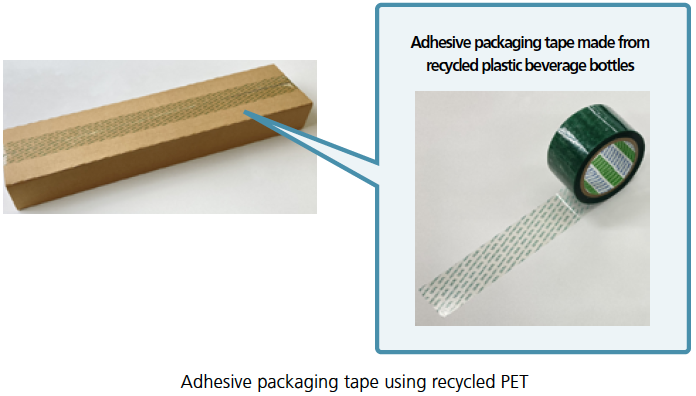
Expanding the scope of material recycling
Material recycling is an activity positioned in the outer loop of product and part reuse in the Comet Circle. Since the 1990s, the Ricoh Group has been promoting high-quality and continuous material recycling through recyclable design. In response to the risks of mineral resource depletion and environmental destruction caused by resource mining, we are further expanding the scope of material recycling as a concrete measure to achieve resource conservation targets for fiscal 2020, 2030 and 2050.
Main areas of activity of this initiative are highlighted on the Comet Circle.
Key partners.
‐Materials manufacturer
‐Materials recovery company
‐User of recycling materials
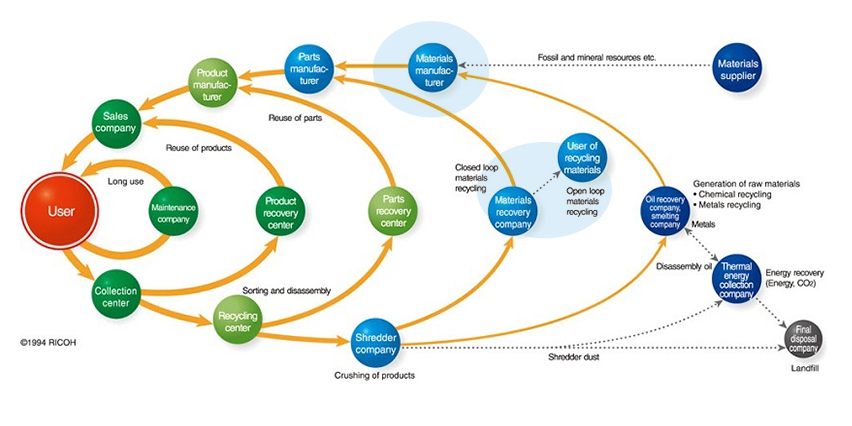
1. Usage of recycled plastic
The Ricoh Group has traditionally labeled the material and grade of each part during manufacturing, and it has maintained the quality of recycled plastic by recycling each grade after collecting the product.
Through this, we have realized horizontal recycling that recycles collected exterior and inner parts into those that require the same high quality characteristics (flame resistance, durability, strength, etc.) In addition, from 2016, using commercially available recycled plastic materials*1, we have developed a recycled plastic that can be used repeatedly for inner parts, and we have begun using it in combination with a similarly developed recycled exterior plastic for MFPs.
We also use recycled plastic made from 100% commercially available recycled plastic materials for our toner containers. This recycled plastic toner container is used in more than 95% of the office toner containers*2 manufactured by the Ricoh Group.
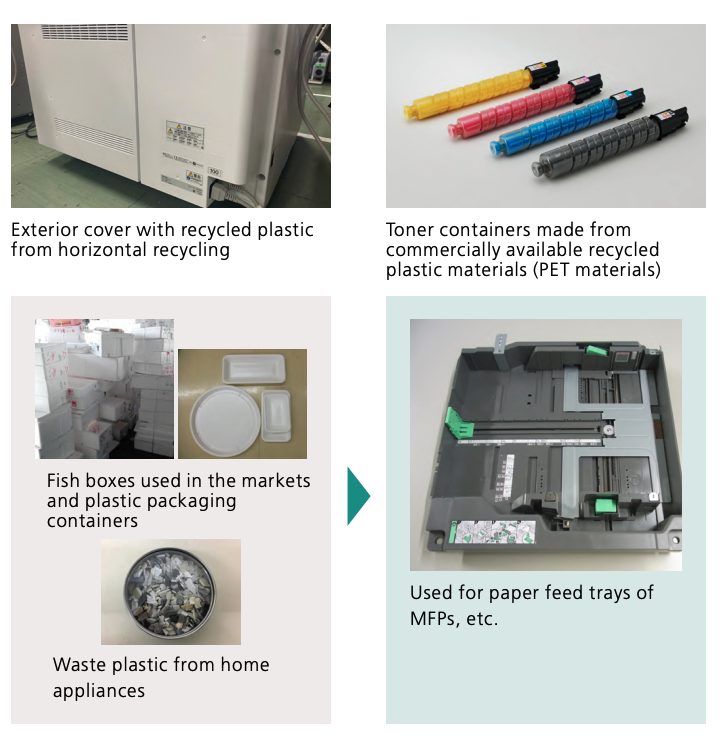
2. Using Electric Furnace Steel Plates
We jointly developed electric furnace steel plates with Tokyo Steel Manufacturing Co., Ltd., that offer the same quality as plates from blast furnaces. In 2012, we were the first in our industry to use these materials in office equipment.
Until then, plates from electric furnaces were mostly for construction material because of their strength. Ricoh specified the materials requirements for office equipment, with Tokyo Steel developing materials for plates that are just 2mm thick or less, improving electrical conductivity, and enhancing pressing and forming. Tokyo Steel employed its advanced impurity removal and rolling technologies to develop and produce high-performance steel plates for office equipment.
Ricoh high-speed MFPs and production printers incorporate these plates. We are also expanding the range of parts employing them. We will further reduce new resource inputs as we broaden the range of products in which we use these plates.
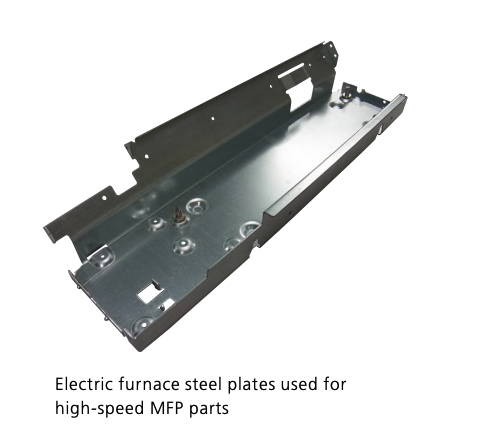
New business products that reduce environmental impact
The Ricoh Group will continue to create new value by adding advanced digital technologies to optical, imaging, materials, manufacturing, control systems, and other technologies it has been working on for many years and combining them with original ideas.
We will provide new products and services that contribute to the realization of a Circular Economy.
Main areas of activity of this initiative are highlighted on the Comet Circle.
Key partners.
‐User
‐Maintenance company
‐Recycling center
‐Materials supplier
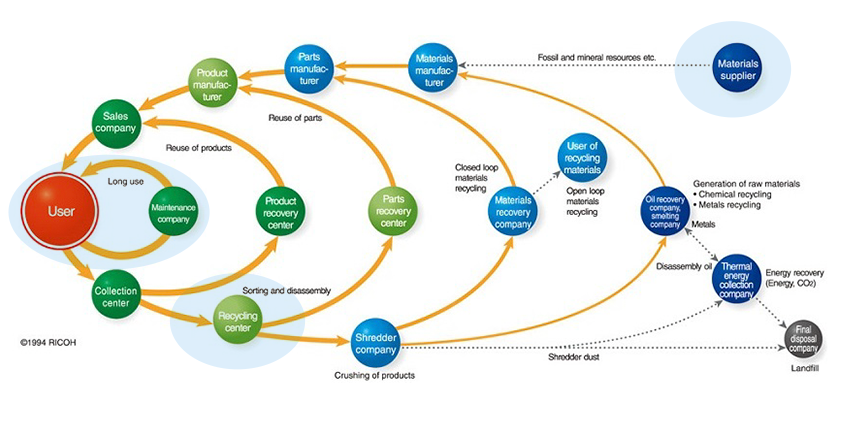
Development of New Technologies that lead to Resource Reduction
1. Silicone-top Linerless Label (SSL) Technology
We launched our Silicone-Top Linerless Label in 2014. Adhesive labels by release paper are mainstream but in response to a growing desire to waste reduction and CO2 emissions. This paper liner less thermal
label draws on the thermal paper technology that we have accumulated over many years.
This innovative label conserves resources by reducing paper consumption (resource conservation) helps reduce environmental impact (reducing CO2 emissions).
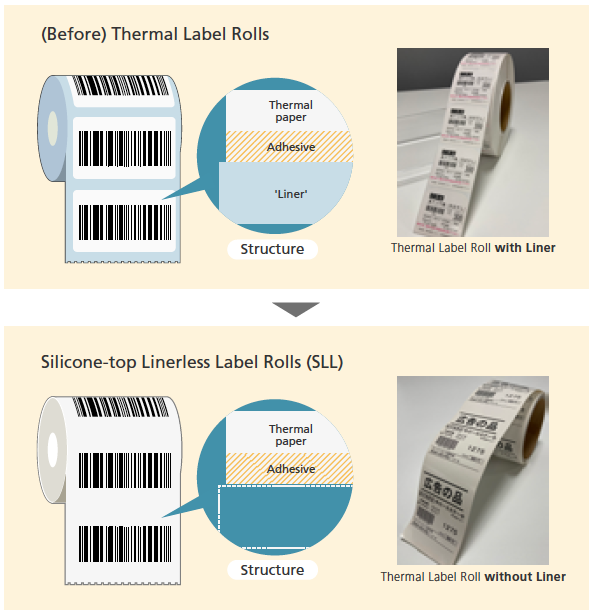
2. Labelless thermal technology that enables direct printing on substrates
Labelless thermal technology is a technology that directly prints variable information without using labels or thermal transfer ribbons.
It is a printing process that makes it possible to improve business efficiency and reduce costs.
Since it is labelless and can reduce the plastic and paper resources used for labels, it contributes to the reduction of environmental impact.
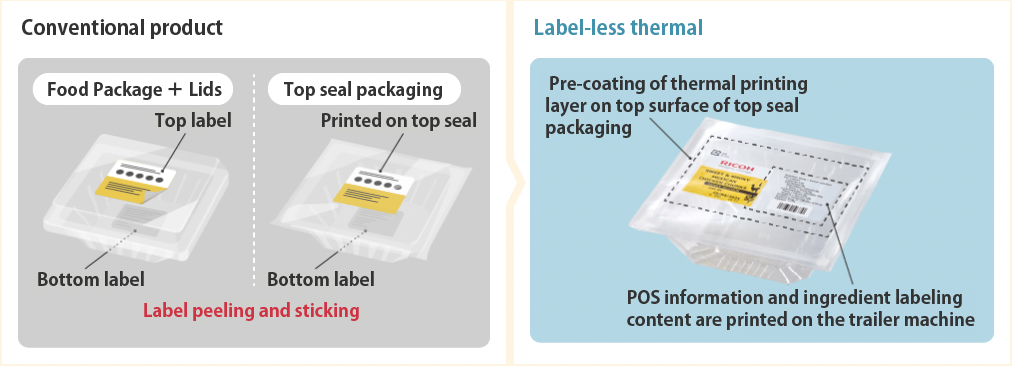
3. Laser marking technology for transparent resin
Asahi Soft Drinks Co., Ltd. started the test-marketing, with our technology, for “Asahi Jurokucha PET630ml Direct Marking Bottle” from December 2021.
The shrink label wrapped around the beverage PET bottle is not materials of PET, we need to peel it off and separate, when needed to recycle. Some products are in the market without the labels, however it is necessary to describe the product information, etc. In the case, it is necessary to take measures such as selling by case or attaching a tack sticker.
By directly writing the product name, raw material, etc. on the PET bottle with a laser, the information display specified by the Food Labeling Law etc. can be realized completely without any labels.
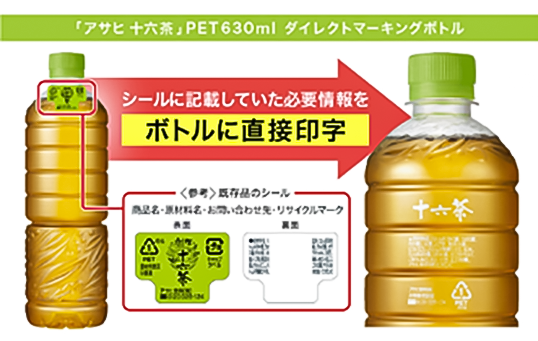
4. Developing Solid-State Dye-Sensitized Solar Cells (as Environment Sensor)
We launched environmental sensor devices which acquire environmental information of such as offices and commercial facilities without the need to replace a battery or rely on a wired connection.
The products are equipped with the developed solid-state dye-sensitized solar cell module “RICOH EH DSSC series”.
‐Environmental sensor “RICOH EH environment sensors D201/D202” that can be used in freezing, high-temperature and high-humidity environments.
‐CO2 sensor “RICOH EH CO2 sensor D101” that can acquire CO2 concentration in addition to temperature, humidity, illuminance and atmospheric pressure.
With these products, it is possible to eliminate the labor of manually recording temperature and humidity, replacing batteries, and wiring when measuring environmental information at food processing and manufacturing sites, retail stores, etc., contribute to DX of environmental management.
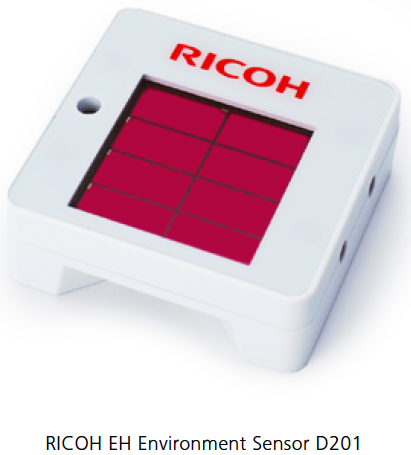
5. HANDY DETECTOR for PLASTIC
Ricoh has newly developed the RICOH HANDY PLASTIC SENSOR B150, a compact and lightweight handy sensor that can easily identify plastic resin materials.
This sensor was developed for business applications involved in plastic recycling, targeting waste plastic dischargers and intermediate processing companies.
Since resin materials can be distinguished without special knowledge, waste plastic can be easily sorted, enabling efficient recycling of resources.
